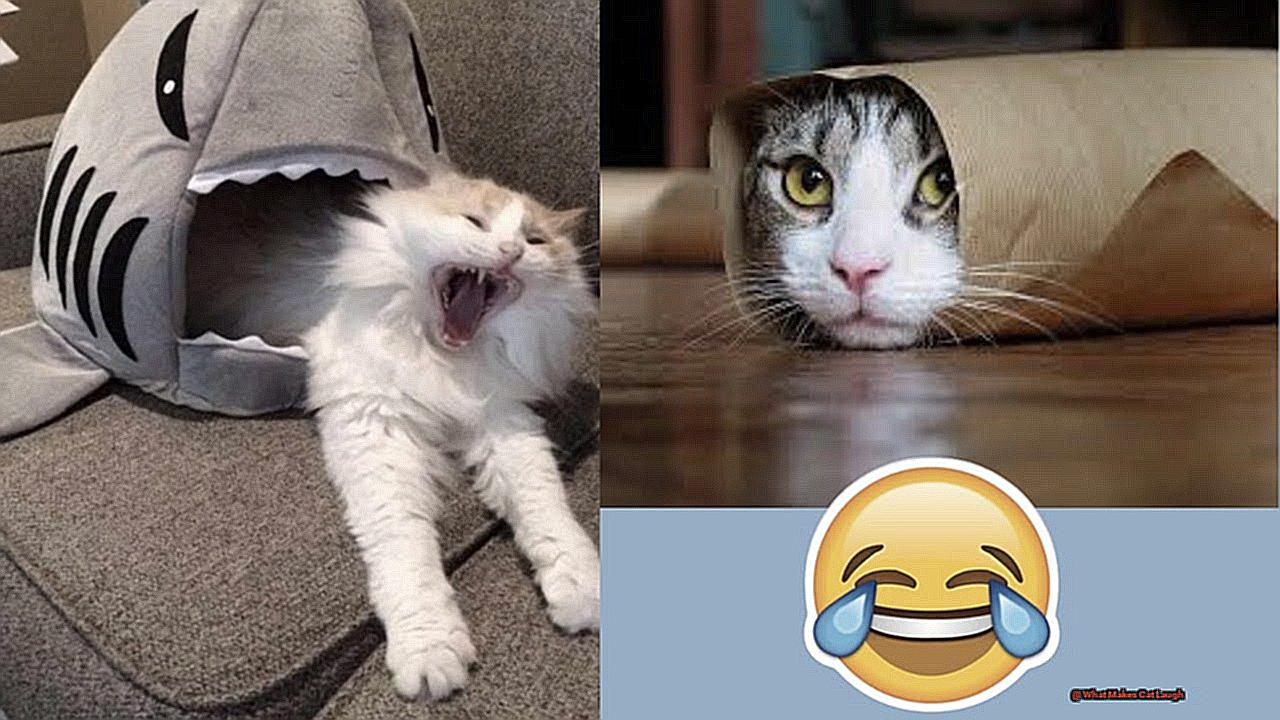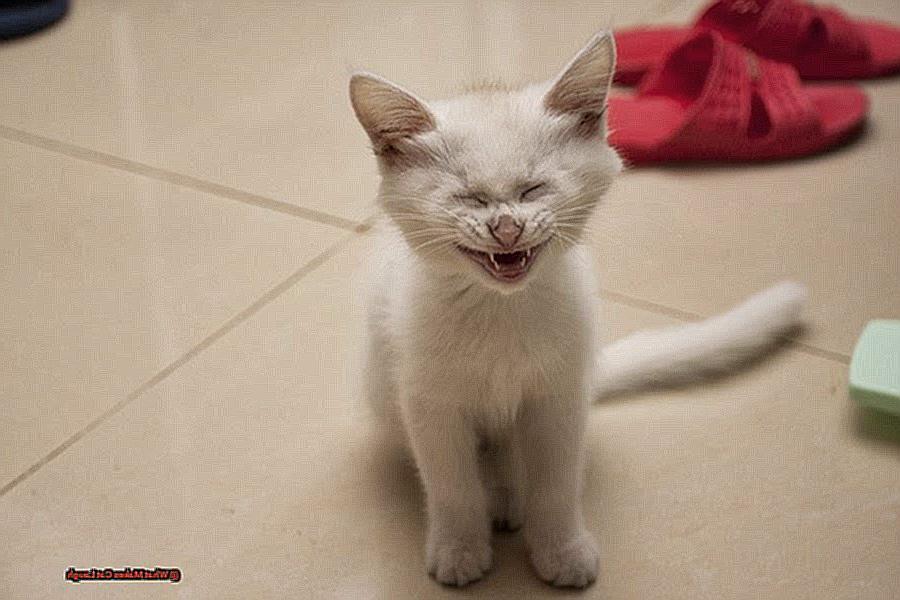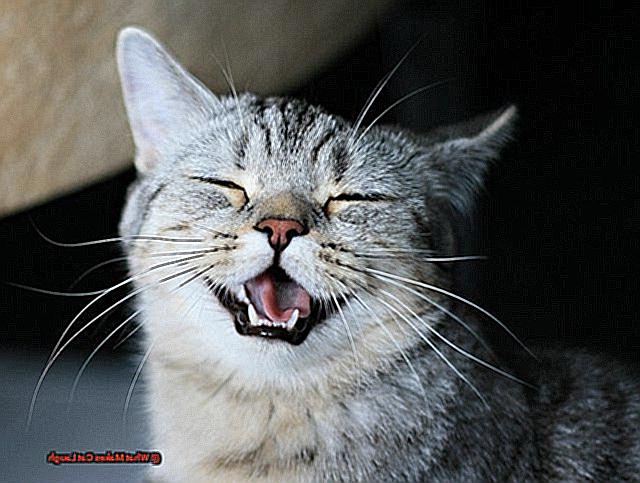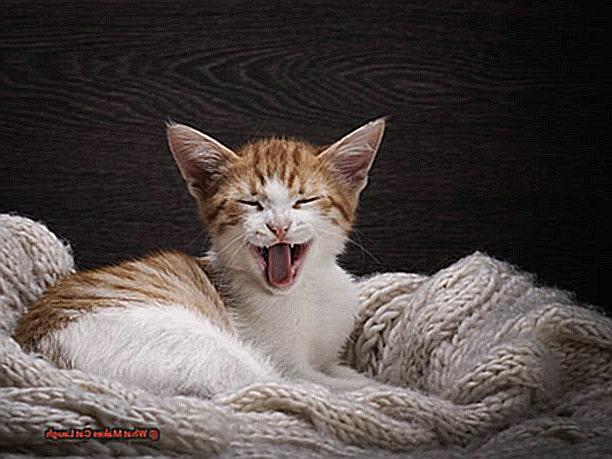Ever caught your cat in a moment of pure amusement and wondered, “What’s got them cracking up?” Well, my fellow feline enthusiasts, prepare to dive headfirst into the enigmatic world of cat laughter. I’ve embarked on a quest to unravel the secrets behind those contagious kitty giggles and discovered some mind-blowing insights that will leave you grinning from ear to ear.
You might be thinking, “Cats laughing? Isn’t that just for humans?” Think again. Recent studies suggest that our furry companions have their very own brand of laughter. But don’t expect knee-slapping hilarity or snorts of glee like ours. No, no. Cat laughter is more like a stealthy ninja – subtle and almost undetectable. It’s all about a low-pitched purring sound called a “chirr,” which serves as their secret language of laughter.
Turns out, cats use laughter as a way to communicate with us mere mortals. When they’re purring away, it signals that they’re comfortable, contented, and forming social bonds with us. And let me tell you something – when our cats strut their stuff or engage in playful shenanigans, they know exactly how to tickle our funny bones. They’re masters at reading our reactions. So if something they do gets us chuckling, you better believe they’ll keep doing it for more laugh-out-loud moments.
Now, what exactly sets off these feline fits of giggles? One word: playtime. Picture this: your cat gracefully leaping through the air after an elusive toy or engaging in an epic battle with an imaginary foe. Hilarious, right? Add in their laughter-like purring, and you’ve got yourself front-row seats to the ultimate comedy show. Even the simplest acts like swatting at a feather toy or pouncing on a dust bunny can turn into side-splitting spectacles.
But here’s the thing – every cat has their own unique sense of humor. Some find slapstick comedy uproarious, while others prefer clever interactions or unexpected surprises. Just like us humans, our furry pals come in all shapes and sizes, with personalities and senses of humor as diverse as the stars in the night sky.
Get this: cats are not immune to the contagious power of human laughter. Ever had one of those laugh attacks that seem impossible to stop?
What makes cat laugh
Have you ever wondered what makes your whiskered friend burst into laughter? Cats may not laugh like humans do, but they have their own unique ways of expressing joy and amusement. In this article, we’ll explore the fascinating world of feline humor and uncover what makes cats laugh.
Playtime Antics – The Cat’s Comedy Club
Unexpected Surprises – The Element of Surprise
Cats are natural-born explorers, and unexpected surprises can leave them in stitches. Imagine sneaking up on your cat from behind a door, only to watch them leap in surprise. Introducing new toys or objects can also elicit laughter-like responses as cats investigate and interact with their environment.
Catnip-Induced Hilarity – The Herb That Brings Laughter
Ah, catnip. This aromatic herb from the mint family has the power to induce euphoria in many feline companions. When exposed to catnip, some cats may roll around, engage in playful behaviors, or perform funny antics that resemble laughter. Just remember, not all cats respond to catnip in the same way.
Social Interactions – The Joy of Togetherness
Cats crave companionship and enjoy interacting with their human caregivers or fellow furry pals. Gentle play, attention, and affection can ignite laughter-like responses in cats. Be prepared for head-butts, leg rubs, and even playful nibbles during your bonding sessions.
Environmental Stimuli – A World of Amusement
Cats are keen observers of their surroundings, and certain environmental stimuli can trigger laughter-like responses. Watching birds through a window, observing moving objects, or listening to the sound of a running faucet can bring out the chirping and chattering sounds that signify amusement.
The Predatory Instinct and Playtime
Cats are natural-born hunters, and their predatory instincts are deeply ingrained in their DNA. During playtime, these instincts come to life as they engage in activities that mimic hunting behaviors. Let’s dive into the fascinating world of cat playtime and explore how it satisfies their predatory instincts while bringing laughter and joy to both cats and their human companions.
Interactive Toys: A Cat’s Ticket to Laughter
When it comes to playtime, interactive toys are the ultimate ticket for a cat’s laughter. These toys are designed to replicate the movement and behavior of prey, such as small rodents or birds. With feathers, strings, or small objects that can be chased, pounced on, and captured, these toys bring out the wild side of our feline friends.
As they swat, chase, and capture these toys, cats’ predatory instincts take over. Crouching low, stalking their “prey,” and launching into playful pounces, they exhibit behaviors reminiscent of their wild counterparts. The unpredictable movements of these toys trigger excitement and joy, leaving cats laughing with delight.
The Element of Surprise: A Recipe for Feline Giggles
Cats love surprises, and playtime provides the perfect opportunity to indulge in unexpected antics. Whether it’s hiding behind furniture and then suddenly popping out or using toys that move unexpectedly, the element of surprise never fails to bring laughter to our furry friends.
Imagine your cat’s gleeful reaction as they chase after a toy mouse that darts across the room with lightning speed or as they discover a hidden toy waiting for them in a paper bag. These surprises ignite their predatory instincts and keep them entertained for hours on end.

Human-Companion Interaction: A Laughter-Filled Connection
Playtime isn’t just about toys; it’s also about the connection between cats and their human companions. Engaging in playful activities like chasing a laser pointer dot or playing hide-and-seek can be immensely amusing for cats. The laughter shared during these interactions strengthens the bond between cats and their owners, creating moments of joy and connection.
It’s important to remember that each cat has unique preferences and personalities. Some may prefer toys that simulate bird-like movements, while others may enjoy chasing after fast-moving objects. Understanding what brings your cat joy and laughter is key to creating a fulfilling playtime experience.
The Importance of Play: Keeping Cats Happy and Healthy
Regular playtime sessions are essential for a cat’s physical and mental well-being. It helps prevent boredom, obesity, and behavioral issues. By providing a variety of toys and activities that cater to their predatory instincts, we ensure that our furry friends lead happy and fulfilled lives.
Social Interaction and Positive Emotions
Cats, often seen as solitary creatures, are actually social animals that thrive on social interaction. In this blog post, we will explore how social interaction can elicit positive emotions in cats and provide practical tips for engaging with your furry friend. So grab a cup of coffee and get ready to discover the secrets to unlocking joy in your feline companion.
The Power of Play:
- Play behavior is essential for a cat’s development and a great way to foster positive emotions.
- Use interactive toys to stimulate their hunting instincts and provide mental and physical stimulation.
- Engage in gentle physical activity like feather wands or laser pointers to keep them physically fit and promote joy and contentment.
Affectionate Bonding:
- Cats can form strong bonds with their human companions through affectionate behaviors.
- Petting, grooming, and cuddling can elicit positive emotions, promoting comfort and security.
- Understand your cat’s individual preferences for touch and adjust your interactions accordingly.
Social Interactions with Other Cats:
- Cats have complex social hierarchies and benefit from social interactions with their own kind.
- Supervised playdates or introductions can provide an outlet for their social needs.
- Observe their body language during interactions to ensure they are comfortable and happy.
Catering to Individual Preferences:
- Each cat has unique preferences for social interaction.
- Some cats may be more introverted and prefer solitary activities, while others thrive on constant social interaction.
- Observe and understand your cat’s personality to provide the appropriate level of social interaction they need.
Unique Preferences and Personalities
Have you ever wondered what makes your cat laugh? Cats, like humans, have their own unique preferences and personalities that contribute to what tickles their whiskers. As a cat expert, I’ve spent countless hours observing feline behavior and conducting research to uncover the secrets behind a cat’s sense of humor.
So, grab your favorite kitty toy and let’s dive into the fascinating world of feline laughter.
Playtime Shenanigans
When it comes to playtime, every cat has their own idea of fun. Some kitties go wild for laser pointers, while others prefer the thrill of chasing feather toys. It’s important to pay attention to your cat’s reactions during play and note which toys make them purr with delight. Experiment with different types of toys and activities to discover what brings out the giggles in your furry friend.
Puzzle Time Pizzazz
Interactive puzzle toys are a fantastic way to challenge your cat’s mind and provide entertainment. Some cats find joy in solving puzzles or hunting for treats hidden within toy mazes. Others may prefer the simplicity of batting around crumpled paper balls or playing with household items. Get creative and observe which activities bring out the mischievous twinkle in your cat’s eyes.
Personality Plays a Part
Just like humans, cats have individual personalities that influence their sense of humor. Some cats are outgoing and playful, while others are more reserved and prefer quieter forms of entertainment. Take the time to understand your cat’s unique personality traits and tailor their playtime experiences accordingly. This will help create a deeper bond between you and your fur baby.
The Power of Interactive Playtime
As a cat owner, you play a crucial role in bringing laughter into your cat’s life. Engage in interactive play with your feline companion using toys that they find entertaining. This not only provides physical and mental stimulation for your cat but also strengthens the bond between you both. So grab that wand toy and get ready for some quality playtime.
Expressing Laughter Through Body Language
As a cat owner, you’ve probably wondered if your feline friend has a sense of humor or if they can express laughter like humans. While cats may not laugh in the same way we do, they definitely have their own ways of expressing joy and amusement through body language. In this section, we will explore the various ways cats use their bodies to show laughter and share some insights based on my experience and research.
Tail Movements: The Tale of the Tail
A cat’s tail is like a window into its emotions. When your cat is happy and content, you may notice its tail held upright with a slight curve at the end. This gentle curve can be seen as a smile, indicating that your cat is feeling joyful and amused. Additionally, a relaxed and playful cat may wag its tail from side to side or flick it sporadically, showing its excitement and amusement.

Purring: The Sweet Melody of Happiness
We all know that purring is a sign of contentment in cats, but did you know it can also indicate amusement? When your cat is in a playful mood or simply feeling happy, you might hear them purring softly. It’s their way of expressing their joy and letting you know that they’re having a good time.
Playful Behaviors: Let the Games Begin.
Playtime is an essential part of a cat’s life, and it’s also when they are most likely to show their laughter. When your cat is in a playful mood, they may engage in various behaviors that bring them joy. You might see them pouncing on toys, chasing imaginary prey, or even play-fighting with you or their feline companions. These actions are not only expressions of happiness but also their way of sharing the laughter with you.
Vocalizations: Meows and Trills
While cats may not laugh audibly like humans, they do have a wide range of vocalizations that can convey their emotions. When your cat is excited or amused, you might hear them chirping or trilling. These unique sounds are often associated with joy and can be considered their version of laughter. Some cats may also make high-pitched meows or short bursts of rapid purring when they are particularly happy or amused.
Body Posture: Striking a Pose
Just like humans, cats use their body posture to communicate their emotions. When your cat is feeling relaxed and content, you might notice them adopting a loose and open posture, with their body stretched out or lying on their back, exposing their belly. This posture is a clear indication that your cat is happy and comfortable.
On the other hand, when your cat is in a playful mood, they may crouch low to the ground, wiggling their hindquarters in anticipation of pouncing. This posture shows their excitement and amusement, as if they’re saying, “I’m ready to have some fun.”
Stimulating Environments for Maximum Joy
When it comes to maximizing joy and happiness in our feline friends, creating a stimulating environment is key. Cats are curious creatures with a natural inclination to explore and engage with their surroundings. By providing an environment that caters to their instincts and needs, we can ensure that they lead happy and fulfilling lives. Here are some tips on how to create a stimulating environment for your cat:
- Enrichment activities: Cats need mental and physical stimulation to thrive. Introduce a variety of toys that offer different challenges, such as puzzle toys that dispense treats or interactive toys that require them to chase or bat at objects. Rotate the toys regularly to keep them interesting and prevent boredom.
- Vertical spaces: Cats love to climb and observe their environment from an elevated position. Install cat trees, shelves, or window perches to give them the opportunity to fulfill their natural desire to be high up. This not only provides them with exercise but also mental stimulation as they survey their territory.
- Hiding spots: Cats are solitary animals that appreciate having their own private space. Create hiding spots in the form of cat caves, boxes, or cozy blankets where they can retreat and feel safe whenever they need some alone time.
- Outdoor enclosures or catio: If you have the space and resources, consider building an outdoor enclosure or catio for your cat. This allows them to experience the outdoors while keeping them safe from potential dangers. Fresh air, sunshine, and the sights and sounds of nature can greatly enrich their lives.
- Scratchers: Scratching is a natural behavior for cats that helps keep their claws healthy and allows them to mark their territory. Provide appropriate scratching surfaces like scratching posts or boards to redirect this behavior away from your furniture.
- Interactive playtime: Engaging in play sessions with your cat not only strengthens your bond but also provides mental and physical stimulation. Use toys like feather wands or laser pointers to mimic prey-like movements and encourage your cat to run, pounce, and jump.
- Visual and auditory stimulation: Cats are visually oriented animals. Place bird feeders or create a small fish tank near their favorite resting spots to provide visual stimulation. Additionally, playing calming music or nature sounds can create a soothing ambiance for your feline friend.
Toys That Bring Out the Playful Side of Cats
Cats are known for their playful nature, and providing them with toys is a fantastic way to bring out their inner kitten. Not only does playtime keep them entertained and mentally stimulated, but it also helps to keep them physically active and healthy. So, let’s dive into the world of toys that are sure to make your feline friend laugh and have a paw-some time.
- Interactive Toys: These toys are the cat’s meow when it comes to engaging your furry friend in play. Whether it’s a laser pointer or a toy that requires them to push buttons or chase moving parts, interactive toys are guaranteed to get your cat’s attention. Just watch as they pounce, stalk, and leap in an attempt to catch their elusive prey.
- Feather Wands: If you want to unleash your cat’s hunting instincts, look no further than feather wands. These toys mimic the movements of birds or insects, triggering a cat’s natural instinct to pounce and chase. It’s like having a mini wildlife adventure right in your living room.
- Catnip-Filled Toys: Catnip is like a magical herb that can turn even the laziest cat into a playful ball of fur. Catnip-filled toys are infused with nepetalactone, a chemical that acts as a stimulant for most cats. When they interact with these toys, cats often roll around, bat at them, and engage in mock hunting. It’s pure entertainment for both you and your kitty.
- Noisy Balls and Mice: Cats love toys that make noise. Rattling balls or squeaking mice can capture their attention and trigger their hunting instincts. Just be prepared for some hilarious pouncing and chasing as they try to catch their noisy prey.
- Puzzle Toys: Treat your clever kitty to some brain-teasing fun with puzzle toys. These toys require your cat to solve puzzles or manipulate objects to access treats or rewards. Not only do they provide mental stimulation, but they also tap into your cat’s natural curiosity and playfulness.

Remember, variety is the spice of a cat’s life. To keep them entertained and engaged, it’s important to rotate and vary the types of toys you provide. Cats can quickly lose interest if a toy becomes too familiar or predictable. So, keep their toy box stocked with an assortment of interactive toys, feather wands, catnip-filled toys, noisy balls, mice, and puzzle toys.
Safety first. When choosing toys for your feline friend, make sure they are safe to play with. Avoid small parts that could be swallowed or pose a choking hazard. Always supervise your cat during playtime to prevent any accidents.
Engaging in Activities with Your Cat to Make them Laugh
Engaging in activities with your cat is not only a great way to bond with them, but it can also bring out their playful side and make them laugh. Cats have unique personalities and preferences, so it’s important to find activities that they enjoy and find amusing. Here are some ideas to get you started:
- Interactive Toys: Cats love toys that stimulate their natural hunting instincts. Consider getting toys that mimic prey, such as feather wands or laser pointers. These toys allow you to engage in playtime with your cat, encouraging them to pounce, jump, and chase after the toy. Watching your cat’s enthusiastic reaction as they try to catch the elusive prey can be quite comical.
- Hide and Seek: Cats are natural explorers, and they love the thrill of finding hidden treasures. Create a game of hide and seek by hiding treats or small toys around your home for your cat to discover. You can start with easy hiding spots and gradually increase the difficulty level as your cat becomes more adept at the game. The joy on their face when they find a hidden treat is sure to bring a smile to your own face.
- Paper Bag Fun: It’s amazing how something as simple as a paper bag can provide hours of entertainment for a cat. Place an empty paper bag on the floor and watch as your feline friend pounces on it, jumps in and out, and explores its crinkly texture. You can even toss in a few toys or treats to make it even more enticing. Just make sure to remove any handles or strings that could pose a choking hazard.
- Catnip Playtime: Most cats are highly responsive to catnip, a herb that induces a euphoric state in felines. Sprinkle some catnip on toys or scratching posts and let your cat go wild. They may roll around, rub against the toys, or even try to bite them in delight. It’s a hilarious sight to see your cat completely absorbed in their catnip-induced frenzy.
- Feather Chase: Cats are natural hunters, and they can’t resist the allure of a feathered toy. Attach a feather to a string or wand and dangle it in front of your cat. Move it around in different patterns, imitating the movements of a bird or insect. Your cat will likely be captivated by the feather’s unpredictable motions and may even leap into the air in an attempt to catch it.
Remember, while engaging in these activities, it’s essential to prioritize your cat’s safety and well-being. Always supervise playtime and ensure that the toys you provide are free from small parts that could be ingested. Additionally, take note of your cat’s reactions and adjust the activity accordingly. Some cats may prefer a more gentle playstyle, while others may enjoy rough-and-tumble play.
Also Read: Maine Coon Size Comparison To A Dog
Rewards and Treats to Encourage Positive Associations
We all know that our feline companions have unique personalities and preferences. As experts in the field, we understand the importance of positive associations in fostering a strong bond with our cats. In this blog post, we will explore how rewards and treats can be used to encourage positive associations in our beloved furry friends.
Choosing the Right Treats:
- Opt for healthy options: Look for treats specifically made for cats, avoiding those with harmful ingredients. Consult your veterinarian to ensure the treats align with your cat’s dietary needs.
- Catnip: A purrfect choice: Catnip is a herb that stimulates playful behavior in cats. Sprinkle some dried catnip on scratching posts or offer catnip-infused toys for a rewarding and enjoyable experience.
Interactive Toys and Puzzle Feeders:
- Tap into their hunting instincts: Interactive toys and puzzle feeders provide mental and physical stimulation. Hide treats or regular food inside these toys to engage your cat’s natural hunting instincts.
- Keep them entertained: These toys keep your feline friend engaged, preventing boredom and destructive behaviors while providing a rewarding experience.
Positive Verbal Reinforcement:
- Words of encouragement: Cats can associate certain words or phrases with rewards and praise. Use phrases like “good boy” or “good girl” when they perform desired behaviors, such as using the litter box or scratching posts.
- Consistency is key: Over time, cats will associate these words with positive outcomes and may be more likely to repeat the behavior.
Moderation is Key:
- Balance is essential: While rewards and treats are effective tools, it’s crucial to use them in moderation. Overfeeding treats can lead to weight gain and other health issues.
- Consult your veterinarian: Seek guidance on the appropriate serving size and the best options for your cat’s specific needs.


